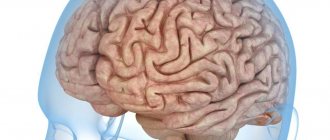Alzheimer's disease
This is a progressive disease with increasing impairment of memory, thinking, intelligence, speech, praxis and recognition, ultimately leading to dementia.
Data on the prevalence of the disease are conflicting. According to some reports, it is 4–5% among people over 60 years of age. The main clinical forms of the disease are Alzheimer's disease itself (with onset mainly in presenile age) and senile dementia of the Alzheimer's type (with onset mainly in old age). An atypical form of the disease with a predominance of frontal lobe atrophy and Alzheimer's type dementia within Down syndrome are also distinguished. Here is a description of the main forms of the disease. 1. Alzheimer's disease . In approximately 80% of cases, it begins at the age of 45–65 years, less often - at the age of about 40 or after 65 years. The duration of the disease is on average 8–10 years, possibly protracted (more than 20 years) and catastrophic (from 2 to 4 years). There are three stages of the disease.
| | Read about diagnosing and treating Alzheimer's disease |
The initial stage includes the stage of “doubtful” dementia and the stage of “mild” dementia. The first stage is manifested by mild disturbances in memory, thinking, speech, praxis, and personality, which are noticeable mainly to the patients themselves and which they manage to hide or compensate for for some time. At the stage of mild dementia, impairments become more serious. Memory for current events decreases, chronological and spatial types of memory suffer.
Violations of various thinking operations are revealed. Disorders of speech, praxis, recognition, and psychopathic personality changes are detected. The severity of the disorders is such that patients can no longer cope independently with professional responsibilities and other types of social activities, such as shopping, paying bills, receiving guests, writing texts, etc.
Patients cope with self-care, although they need outside control and encouragement. Affective and delusional disorders are often observed at this stage. These are subdepressions, sometimes chronic and combined with anxiety, hysteriform and hypochondriacal manifestations; episodic or protracted delusional ideas of damage, theft, less often - ideas of relationship, persecution or jealousy. Some patients show increased exhaustion and headaches; the duration of the initial stage ranges from 4–8 to 15–20 years. At the same time, in some patients, memory impairments predominate, while in another, larger group, focal impairments (aphasia, etc.) prevail.
At the stage of moderate dementia, impairments in the cognitive sphere and higher cortical functions reach a degree where patients can no longer cope with professional and social responsibilities. They need help even with everyday life and self-care. Neurological disorders appear, such as muscle stiffness, akinesia, hyperkinesis, and seizures. A critical attitude towards the disease nevertheless remains. Along with deficient ones, productive disorders are sometimes observed: episodes of hallucinatory confusion, a state of psychomotor agitation, often not associated with a deterioration in the somatic condition. The aphato-apracto-agnostic syndrome (three A syndrome) characteristic of this stage is finally formed, the weakening of memory takes on the character of progressive amnesia. Confabulation and ecmnesia often do not occur.
The stage of severe dementia is characterized by the breakdown of memory, thinking and intelligence, as well as higher cortical functions. Patients need help even with basic self-care. Basically, only in Alzheimer's disease are such profound disturbances, to the point of insanity, observed, as well as fetal position, contractures, multiple violent motor phenomena, violent laughter and crying, and epileptic seizures. At the same time, there are pronounced somatic changes: weight loss, extreme decrepitness, bulimia, endocrine disorders.
2. Senile dementia of the Alzheimer's type. In approximately 80% of cases, it begins between the ages of 65 and 85 years. The duration of the disease ranges from 4 to 15 years or more. In the initial stage of the disease, significant memory impairment for current events develops, often with a revival of memories of the distant past. Thinking operations suffer, as well as intelligence (creativity, planning, forecasting, etc.). Personality changes are characteristic: egocentrism, narrowing of interests, emotional impoverishment, conflict, opposition and suggestibility. Moral decline and disinhibition of drives are also observed.
The suspicion inherent in patients later develops into a tendency to develop delusions. However, half of the patients experience psychotic episodes with low-level delusions. Subdepressive states are also observed, especially gloomy depression. In the second stage of the disease, memory impairment takes on the character of progressive amnesia. There may be scanty confabulations, as well as states of amnestic disorientation with a “shift of the situation into the past.” At the stage of moderate dementia, disorders of higher cortical functions also become clear. At the stage of severe dementia, a complete breakdown of mnestic-intellectual functions is observed, and serious neurological disorders are also detected.
The etiology of Alzheimer's disease has not been established. The role of genetic factors in the development of familial forms of the disease can apparently be considered proven. However, this role remains unclear in sporadic forms, which account for about 90% of all cases of the disease. Aging is essential.
The leading place in the treatment of patients is occupied by replacement therapy aimed at overcoming neurotransmitter deficiency. To compensate for cholinergic deficiency, tacrine, amiridine, exelon, memantine, Aricept, and reminyl may be recommended. To eliminate the deficiency of other neurotransmitter systems, other drugs are recommended, in particular Yumex and Citalopram. To increase the survival of neurons, nootropics are prescribed, especially Cerebrolysin, as well as vasoactive drugs, in particular sermion or nicergoline. Anti-inflammatory treatment such as indomethacin may be helpful. Therapy for psychotic disorders is carried out with the help of antidepressants, antipsychotics, and tranquilizers. The prognosis of the disease is unfavorable.
Diagnosis of encephalopathy
When examined, the vast majority of patients with discirculatory encephalopathy reveal characteristic diseases or physiological characteristics and habits. These risk factors include:
- arterial hypertension (blood pressure from 140/90 mm Hg and above);
- heart diseases (coronary disease, rheumatic lesions, heart rhythm disturbances, etc.);
- diabetes;
- excess body weight;
- sedentary lifestyle;
- hypercholesterolemia (total cholesterol above 6.2 mmol/l);
- long-term and frequent neuropsychic overstrain (stress);
- family history of cardiovascular diseases (stroke, myocardial infarction or arterial hypertension in close relatives);
- smoking;
- alcohol abuse.
Men with rapidly progressing dyscirculatory encephalopathy usually have a history of psycho-emotional stress, a sedentary lifestyle, alcohol abuse, lack of regular treatment and the presence of two or more concomitant diseases. In women, in addition to the listed factors, excess body weight often contributes to the unfavorable course of the disease.
If patients with arterial hypertension and atherosclerosis (or representatives of other risk groups) have complaints of headache, dizziness, decreased performance, memory impairment, then the initial stage of dyscirculatory encephalopathy can be suspected. Patients with such symptoms should, first of all, constantly monitor blood pressure, undergo an electrocardiographic examination, complete general blood and urine tests, and blood tests for sugar and lipids. A psychological study to assess the state of memory, intelligence, attention and speech would not hurt.
Even small nonspecific changes in the electrocardiogram can be harbingers of cardiovascular diseases, manifested in impaired blood circulation in the brain. By the way, normal electrocardiograms or echocardiograms do not exclude the presence of the disease, since changes can only be noticeable at the time of myocardial ischemia (anemia) or an attack of angina. An electrocardiogram taken during physical activity provides important information. Daily monitoring of heart function also allows you to identify abnormalities.
Information about the condition of the fundus (the back wall of the eye), the cells of which are directly connected to the neurons of the brain, is important for making a diagnosis. Changes in the blood vessels and nerve cells of the fundus make it possible to judge about disturbances in the structure of the brain tissue. In patients with discirculatory encephalopathy, hearing is often reduced, the swallowing reflex and sense of smell are impaired. Therefore, to make a diagnosis, it is necessary to conduct an otoneurological study that reveals disorders of the vestibular apparatus, auditory, olfactory and taste perceptions.
Useful information is provided by studying the rheological properties of blood - its fluidity. The main factor influencing the fluid properties of blood and the degree of its saturation with oxygen is considered to be hematocrit - the ratio of the volume of red blood cells to the volume of plasma. Its increase increases blood viscosity and worsens blood circulation. There is a direct connection between high hematocrit and cerebral infarctions.
After preliminary studies, the patient is usually referred for an X-ray examination of the cerebral vessels - angiography. Doctors consider angiography to be the “gold standard” with which the results of other research methods are compared. After the administration of a special contrast agent, X-ray images of the brain vessels are obtained. Angiography provides information about the duration and sequence of filling of blood vessels, about the formed “bypass” circulatory pathways in case of blockage or narrowing of cerebral vessels. The results of the study are important when deciding on the feasibility of surgery.
Electroencephalography is an old and very common method of studying the brain, based on recording its electrical potentials. Changes in the encephalogram indicate organic changes in the brain tissue, therefore, at the initial stage of the disease with dyscirculatory encephalopathy, encephalography may not reveal any abnormalities.
A real revolution in brain research was made by the advent of computed tomography, which combines the achievements of radiography and computer data processing methods. With its help, you can obtain not indirect, but direct data about brain structures and their changes. The method allows you to determine the location and size of brain lesions and their nature.
Magnetic resonance imaging of the brain.
Image of a healthy brain (A); changes in the brain matter in Binswanger's disease - rarefaction of the white matter of the brain (B); hydrocephalus - accumulation of fluid in the brain tissue - manifests itself in the form of expansion of the grooves and ventricles of the brain (shown by arrows) (B); multi-infarct condition - dead nerve tissue appears as small dark spots (shown by arrows) (D). Image: Science and Life
Recently, magnetic resonance methods have been used to diagnose cerebral circulatory disorders: nuclear magnetic resonance, magnetic resonance imaging and magnetic resonance angiography. Nuclear magnetic resonance provides information about the physicochemical properties of brain structures, making it possible to distinguish healthy tissues from altered ones. Magnetic resonance imaging allows you to obtain images of the brain, determine the location, size, shape and number of lesions, and study cerebral blood flow. Magnetic resonance angiography is a modification of magnetic resonance imaging. With its help, you can study the passage and “caliber” of extracranial and intracranial arteries and veins.
Currently, highly informative methods for obtaining three-dimensional images of brain structures have been created and are successfully used: single-photon emission computed tomography and positron emission tomography.
Duplex scanning of the internal carotid artery.
A formed small atherosclerotic plaque is visible, the lumen of the vessel is slightly narrowed (A); later stage of atherosclerosis - the lumen of the vessel of the internal carotid artery is partially blocked by a large plaque (B); occlusion - complete closure of the lumen of the vessel with a plaque (B); artery tortuosity (D) (Image: Science and Life)
Ultrasound methods are widely used to examine patients not only in hospitals, but also in outpatient settings: Dopplerography and echotomography, duplex scanning and transcranial Dopplerography. Doppler ultrasound is used to identify lesions of the carotid and vertebral arteries. It makes it possible to obtain information about the profile of blood flow in the vessels. With duplex scanning, color contrast of flows allows you to more clearly distinguish between moving (blood) and stationary (vascular walls) objects. The main vascular lesions detected by transcranial Doppler ultrasound are blockages, stenoses, spasms and aneurysms. The most complete information about the state of the vascular system of the brain can be obtained by comparing data from various ultrasound methods. Recently, a new method of ultrasound diagnostics has appeared - transcranial sonography with color Doppler coding. With its help, you can “see” the structures of the brain through the bones of the skull.
Pick's disease
This is a systemic degenerative disease with onset in presenile age, leading to personality and adaptation disorders, and subsequently to total dementia, most often of the frontal and frontotemporal type.
Pick's disease accounts for 0.4 to 2% of all cases of dementia in old age. The prevalence of the disease in people over 60 years of age is about 0.1%. Women get sick slightly more often than men (in a ratio of 1.7:1). The disease begins between the ages of 50 and 70 years. The average duration of the disease is six years.
The disease usually begins gradually and progresses quite quickly. The initial stage of the disease is manifested primarily by personality changes. If the pole of the frontal lobe suffers, then apathy and spontaneity predominate. When the orbital cortex is damaged, a pseudoparalytic syndrome develops with euphoria, disinhibition and impaired abstract thinking; memory does not change significantly. When the temporal lobes are damaged, stereotypies of speech, behavior and movement come to the fore. Other variants of the onset of the disease are much less common: a) asthenia and asthenodepressive symptoms, b) aphasia phenomena, c) psychotic disorders with delusions of persecution, jealousy, harm, d) memory loss, due to which there is a similarity with Alzheimer's disease.
In the middle stage of the disease, against the background of disturbances in the most complex forms of mental activity (planning, forecasting, understanding the meaning of life situations, flexibility, criticality, creativity), focal cortical disorders are also detected. Speech impairments usually predominate. This is dynamic, amnestic or sensory aphasia. Echolalia and standing speech patterns are characteristic. Agraphia, alexia, acalculia, and apraxia are relatively less pronounced. There are attacks of muscle relaxation without complete loss of consciousness, amyostatic syndrome, extrapyramidal hyperkinesis, and rarely spastic hemiparesis. The appearance of epileptic seizures most likely indicates Alzheimer's disease. The initial state is similar in its manifestations to the symptoms of the terminal stage of Alzheimer's disease.
The etiology and pathogenesis of the disease have not been sufficiently studied. Treatment is similar to that for Alzheimer's disease. Relatively early-onset personality and behavioral disorders usually require hospitalization.
What foods must be present in the diet?
Speaking about a healthy diet, it is necessary to note the mandatory inclusion of vegetables and fruits of different colors. Fortifying your diet with flavonoids (found in citrus fruits) has also been shown to reduce the risk of ischemic stroke.
Proteins of plant and animal origin are building materials. The daily diet should include meat and fish dishes. It is better to give preference to low-fat varieties and sea fish. To ensure your body gets protein, eat more nuts and legumes.
Plant foods also lower blood pressure and improve vascular elasticity. Add whole grains, brown unprocessed rice, and vegetable oils such as canola, olive, and flaxseed to your diet.
Dairy products should be consumed with a low percentage of fat, especially since many people are now diagnosed with lactose intolerance. If this is your case, and after consuming dairy products you feel discomfort, it is better to drink low-lactose milk or plant milk, or avoid it altogether.
Nutrition is an essential part of preventing stroke and dementia. Without a balanced diet and healthy foods, not a single pill will protect you from atherosclerosis. We are what we eat, don't forget that!
Huntington's chorea
This is a hereditary neurodegenerative disease in the middle and second half of life with a predominant lesion of the striatal system of the brain and less severe damage to other subcortical nuclei and the neocortex. The main manifestations of the disease are decreased intelligence, psychotic phenomena and choreic hyperkinesis.
Due to the fact that the latter sometimes does not develop even in the later stages, the process is also referred to as “Huntington’s disease”.
The prevalence of the disease reaches 4–8 people per 100 thousand population. Among patients in psychiatric hospitals it is 1%. The peak incidence rate occurs between 35 and 50 years of age. The disease lasts from 1 to 25 years.
In approximately half of the cases, the disease develops “due to a nervous defect” (Davidenkov, 1932) in the form of a personality disorder, mental underdevelopment and motor “moronism” (clumsiness, poor handwriting, etc.). The disease does not have a single development pattern. Choreic dementia is characterized by damage to the most complex forms of intellectual activity and uneven mental performance. Intellectual deficits are believed to be based on gross disturbances of attention and spasmodic loss of direction in the movement of thoughts. As intellectual impairments develop, they move closer to dementia.
Psychotic phenomena are recorded in 60% of patients. In Alzheimer's disease they occur in 43.5%, and in Pick's disease - in 11% of patients (Sternberg, 1967). In the early stages of Huntington's disease, predominantly psychogenic disorders are observed, including depression with apathy, hypochondria, or dysphoria. Paranoid psychoses with delusions of jealousy, persecution, and poisoning are relatively common. Later, paraphrenic states with delusions of grandeur, hallucinatory and hallucinatory-paranoid psychoses may develop. The most common hallucinations are tactile, visceral and fragmentary verbal. Choreic hyperkinesis is usually slow, low-amplitude, separated by large intervals; It is also typical that they include torsion and athetoid components and occur against a background of mild muscle hypotonia. Muscle strength decreases, eyelid ptosis and dysarthria occur.
There are abortive forms of Huntington's disease: a) neurological, with a predominance of akineto-hypertensive syndrome; usually begins early, b) with typical hyperkinesis and minimally expressed mental disorders, c) with minimal hyperkinetic and severe mental disorders, d) stationary forms, in which, despite extensive symptoms, the disease lasts for decades, so that patients die from intercurrent diseases. Most patients die in a state of mental insanity; in the terminal stage of the disease, hyperkinesis usually decreases or stops.
It has been established that predisposition to the disease is inherited in an autosomal dominant manner and usually leads to atrophy of the striatum, and to a lesser extent, the cortex. Men get sick more often. Huntington described the disease in two brothers. In 12 families descended from them, 100 cases of the disease were described.
When treating patients, drugs that block dopamine receptors (phenothiazine derivatives, butyrophenones) or reduce the content of dopamine in tissues (reserpine, methyldopa) are used. Psychotic disorders are an indication for the use of aminazine, tizercin, propazine or teralen, and other antipsychotics. The results of therapy are usually disappointing. The prognosis of the disease is generally unfavorable.
Why do organic lesions develop?
The causes of organic damage to the central nervous system include:
1. Peri- and intranatal pathology (brain damage during pregnancy and childbirth). 2. Traumatic brain injuries (open and closed). 3. Infectious diseases (meningitis, encephalitis, arachnoiditis, abscess). 4. Intoxication (abuse of alcohol, drugs, smoking). 5. Vascular diseases of the brain (ischemic and hemorrhagic strokes, encephalopathy) and neoplasms (tumors). 6. Demyelinating diseases (multiple sclerosis). 7. Neurodegenerative diseases (Parkinson's disease, Alzheimer's disease).
A huge number of cases of the development of organic brain damage occurs due to the fault of the patient himself (due to acute or chronic intoxication, traumatic brain injury, incorrectly treated infectious diseases, etc.)
Parkinson's disease
This is an atrophic disease of the brain in old and senile age, manifested by extrapyramidal and mental disorders, including dementia.
Occurs with a frequency of 0.08 to 0.2%. 11% of patients show symptoms of dementia. Men get sick more often. The disease begins between the ages of 45 and 75 years, more often at 50–65 years. The main symptoms of the disease are tremor, muscle rigidity, hypokinesia, and paralysis. Obligatory disorders also include permanent and paroxysmal autonomic disorders, as well as personality changes in the form of psychopathization. Half of the patients experience depression, including suicidal tendencies. Querulant tendencies, low-grade delirium, and, in later stages of the disease, hallucinosis, visual or tactile, and states of confusion (delirium) may occur. Visceral hallucinosis is very characteristic. In 15–25% of patients, signs of cognitive deficit are detected, and in elderly patients, in addition, defects in memory, praxis and optical-spatial activity are detected. Pictures of dementia resemble those of Alzheimer's disease. Prospective studies have shown that there is a positive correlation between the ilateral presentation of motor disorders and the risk of developing cognitive deficits.
Predisposition to the disease is transmitted in an autosomal dominant manner with 25% penetrance. The main role in the genesis of symptoms is given to dopaminergic dysfunction of the brain, especially neurons of the substantia nigra. Other brain systems, including cortical structures, may also be involved in the disease process.
The leading place in the complex treatment of the disease is occupied by therapy with L-DOPA and drugs containing it (Madopar, Sinemet, Nakom). These drugs are usually combined with the prescription of anticholinergic drugs (midantan, akineton, parkopan, cyclodol, etc.). There is evidence of positive results from the administration of bromocriptine, parlodel, selegiline, Yumex, and cognitive, which increase dopamine levels in the brain. If psychotic disorders occur, it is recommended to prescribe small doses of antipsychotics while simultaneously reducing the doses of antiparkinsonian drugs and detoxification. The prognosis of the disease is determined by the severity of neurological disorders and its progression.
Back to contents
Types of brain malformations
There are many similar anomalies. Among them there are both very rare and more common diseases. Common developmental defects include:
- micro- and macrocephaly - decrease and increase in the size and mass of the brain, respectively;
- anencephaly - its complete absence;
- agyria - absence of convolutions of the cerebral cortex;
- holoprosencephaly - absence of the central sulcus, which divides the brain into two hemispheres;
- underdevelopment of the corpus callosum.
These disorders are accompanied by various disorders of the psychoemotional sphere, speech, motor functions, and in severe cases can lead to death. Some disorders respond well to correction, while others remain with the patient for life.











